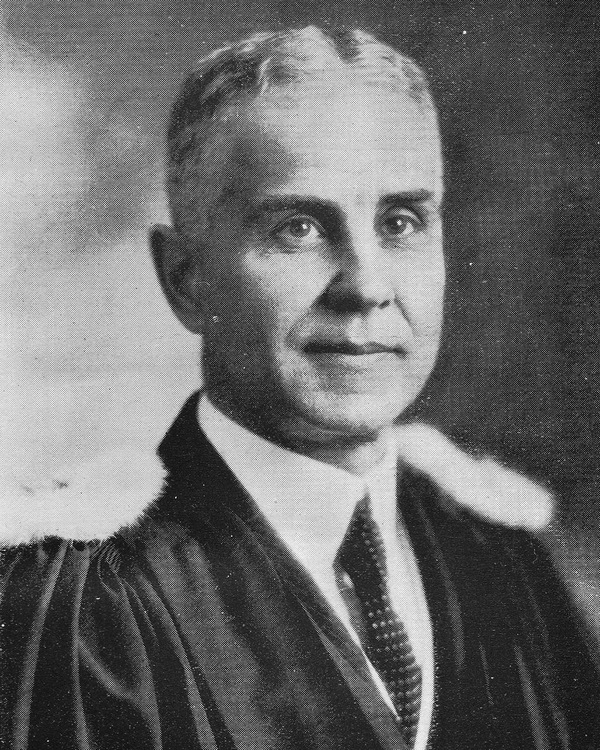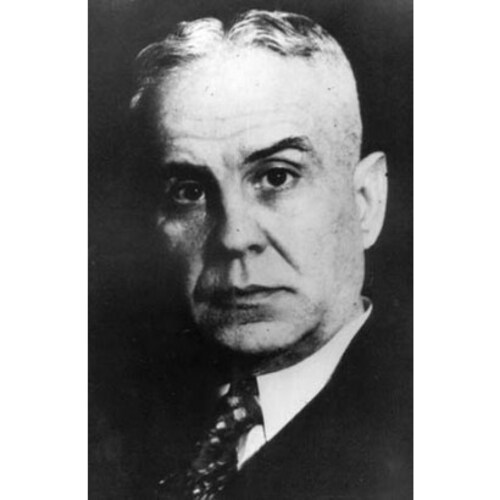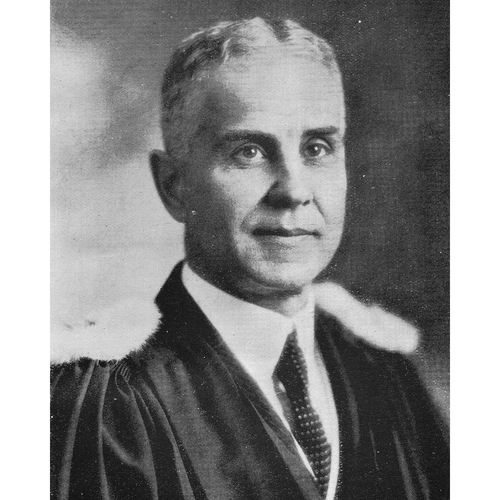
Source: Link
Derome, Wilfrid (baptized Joseph-Wilfrid, he sometimes signed G.‑Wilfrid Derome), forensic pathologist, professor, public servant, and author; b. 19 April 1877 in Saint-Cyprien (Napierville), Que., son of Médard Derome, a farmer, and Philomène Fortin; m. 16 Aug. 1909 Catherine Dubuc in Shelburne, Vt, and they had a son and a daughter; d. 24 Nov. 1931 in Montreal.
Wilfrid Derome attended the Petit Séminaire de Montréal from 1890 to 1893 and the Collège Sainte-Marie in Montreal between 1893 and 1896. He completed his classical studies at the Collège Joliette in 1898. He then enrolled in the faculty of medicine at the Université Laval in Montreal, where, after receiving first-class honours in all his subjects, he obtained an md in 1902.
An intern at the Hôpital Notre-Dame from 1903 to 1904, Derome was a histology demonstrator from 1904 to 1908 for the faculty of medicine at the Université Laval in Montreal, where he worked under one of his former professors, the physician Amédée Marien. In 1907 he was appointed director of the pathology laboratory at the Hôpital Notre-Dame. He then took a year’s leave to specialize in forensic medicine at the Sorbonne in Paris, studying with teachers such as Alphonse Bertillon, Léon-Henri Thoinot, and Victor Balthazard. The institution awarded him a diploma in forensic medicine and psychiatry. On his return to Montreal in 1909 Derome again took charge of the Hôpital Notre-Dame’s pathology laboratory. That year, on the recommendation of his former professor, the physician Georges Villeneuve, a forensic-medicine specialist and superintendent of the Hôpital Saint-Jean-de-Dieu, he was also appointed chair of forensic medicine at the medical faculty of the Université Laval in Montreal, and then, in 1914, full professor. Again through Villeneuve’s support, he had served as medical consultant at the Hôpital Saint-Jean-de-Dieu in 1910. He was also the director of the Institut Bruchési’s laboratory from 1912 to 1920. In 1926, when Pierre Masson* was made head of the pathology laboratory at the Hôpital Notre-Dame, Derome was named director of the hospital’s bacteriology, chemistry, and serology laboratory, a post he would hold for the rest of his life.
In 1910 Derome had become an assistant specialist at the Montreal morgue. At this time he began to write a series of articles on forensic medicine for L’Union médicale du Canada. He wanted to set up in Quebec a system of forensic investigation similar to the one he had observed in France. In the British system, both parties appear in court accompanied by their physicians; in the French system, formal inquiries are carried out by an impartial commission appointed by the presiding judge from a list of qualified specialists. Their report is given to the court and can be consulted by the two parties. On 5 Oct. 1909, at a meeting of the Société Médicale de Montréal, Derome had presented a motion for reorganizing the forensic system in which he proposed that the government designate forensic specialists as experts in court and establish forensic laboratories. Adopted unanimously by the society, the resolution was also backed by the council of the Montreal bar a few weeks later, and then by the College of Physicians and Surgeons of the Province of Quebec.
Following numerous meetings with members of the Société Médicale de Montréal, the Liberal government of Sir Lomer Gouin* recognized as early as 1911 the value of setting up the Laboratoire Provincial de Recherches Médico-légales. It was founded in 1914 with Derome as its first director. Established in the Montreal morgue, the laboratory, named the Laboratoire de Sciences Judiciaires et de Médecine Légale at the turn of the 21st century, was the first of its kind in North America and would be the only one in Canada until 1928. It was created to facilitate police inquiries and the judicial process by using scientific techniques to discover the causes of injury and death, explain the circumstances of a crime, and identify victims and guilty parties. The laboratory was equipped with a variety of instruments (microscope, counterbalance, emission spectrograph, and the like) to conduct the most common analyses. It housed a library and a museum that displayed anatomical models and objects related to certain criminal cases. In 1919 Derome had engaged Franchère Pépin, a chemist and pharmacologist specializing in toxicological research. A forensic photographer hired in 1920, as well as a technician, completed the staff of the laboratory, which after Derome’s death would be run by his assistant, the physician Rosario Fontaine.
In other respects, Derome had continued to promote and refine his plan to reform forensic investigation. However, it was criticized in 1917 by Villeneuve, who late in life had become a supporter of the British system. At the seventh convention of the Association des Médecins de Langue Française de l’Amérique du Nord, held in 1922 in Montreal, Derome presented a 17-point reform initiative that he had developed with Rosario Genest, a professor of civil procedure at the Université de Montréal. In particular, it provided for the creation of three categories of court experts: the first would be charged with investigating industrial accidents, the second with examining the issue of legal liability, and the third with determining the cause of death. Derome’s efforts bore fruit in the area of industrial accidents, among others, with mandatory investigation instituted from 1924.
During the 1920s Derome testified at the most significant criminal trials in Canada. The most famous were those of Marie-Anne Gagnon, the stepmother of Aurore the martyred child [Aurore Gagnon*], in 1920, and of the Abbé Adélard Delorme, on trial in 1922 and 1923 for the murder of his brother. A few months before his own death, Derome would also appear as an expert witness at the trial of Michael Sowry, suspected of having killed Joseph and Annie Babchuck in the vicinity of Fort St John (near Fort St John, B.C.).
Derome was the greatest ballistics expert of his time in North America. In 1929 he published Expertise en armes à feu (Montreal), a treatise based on his 20 years of experience in the field. With a preface by his former teacher Balthazard, the work won him international recognition because it was the first study to assemble information on global arms and munitions. Derome’s reputation was such that the American authorities asked for his advice on how to set up the future technical laboratory of the Bureau of Investigation, and several police forces made him offers to settle in the United States.
Derome had also been a corresponding member of France’s Société de Médecine Légale from 1914, a member of the board of L’Union médicale du Canada from 1925, and associate editor of a Chicago review, American Journal of Police Science, when it was founded in 1930. As well, he was the author of Précis de médecine légale, published in Montreal in 1920, of which he was preparing a second edition at the time of his death.
A man of science ahead of his time, Wilfrid Derome made the fight against crime his life’s work. His death in 1931 from cancer was seen as a great loss not only for French Canadian medicine but also for the international scientific community.
In addition to the works mentioned in the biography, Wilfrid Derome is the author of several scientific articles; the most complete bibliography of these writings can be found in Jacques Côté, Wilfrid Derome, expert en homicides: récit biographique (Montréal, 2003). BANQ-CAM, CE604-S6, 19 avril 1877. Musée de la Civilisation (Québec), Fonds Laboratoire de médecine légale (CA1996-123), Documentation concernant le laboratoire médico-légal; Dossier documentaire sur l’historique de l’Instit. de médecine légale. Le Devoir, 24 nov. 1931. La Presse, 30 juill. 1914, 26 janv. 1924. Vancouver Sun, 24 Nov. 1931. Ancestry.ca, “Vermont marriage records, 1909–2008”: www.ancestry.ca (consulted 18 Aug. 2015). Rosario Fontaine, “Nécrologie: le professeur Wilfrid Derome,” L’Union médicale du Canada (Montréal), 61 (1932): 1–3. Lucienne Fortin et J.‑L. Foucault, Napierville au fil des ans: essais d’histoire et répertoire des baptêmes, mariages et sépultures, 1823–1983 ([Napierville, Québec], 1985). Lorraine Gadoury and Antonio Lechasseur, Persons sentenced to death in Canada, 1867–1976: an inventory of case files in the Fonds of the Department of Justice ([Ottawa], 1994). Denis Goulet et André Paradis, Trois siècles d’histoire médicale au Québec: chronologie des institutions et des pratiques (1639–1939) (Montréal, 1992). Guy Grenier, 100 ans de médecine francophone: histoire de l’Association des médecins de langue française du Canada (Sainte-Foy [Québec], 2002). Hôpital Notre-Dame, Rapport annuel (Montréal), 1903–29. Instit. Bruchési, Annual report of the dispensary and preventorium (Montreal, [1911–12]); Rapport triennial … ([Montréal, 1912–15]); Rapport annuel … ([Montréal, 1916–20]); Rapport biennal … ([Montréal, 1920–22]). Jean Monet, La soutane et la couronne: le procès du siècle, l’affaire Delorme (Saint-Laurent [Montréal], 1993). Bernard Péclet et J.‑P. Valcourt, “Criminologie et médecine: l’Institut de médecine légale et de police scientifique,” Le Médecin du Québec (Montréal), 11 (1976), no.7: 49–60. Que., Parl., Sessional papers, 1911–15 (Report of the inspectors of asylums, reformatory schools and industrial schools of the province of Quebec, 1910–14). Univ. Laval à Montréal, Directory, 1902–3, 1904–6, 1908–16; Faculté de médecine, Directory, 1899–1902. G. Villeneuve, “M. le Dr G. Wilfrid Derome,” L’Union médicale du Canada, 43 (1914): 175–76.
Cite This Article
Guy Grenier, “DEROME, WILFRID (baptized Joseph-Wilfrid) (G.-Wilfrid Derome),” in Dictionary of Canadian Biography, vol. 16, University of Toronto/Université Laval, 2003–, accessed December 29, 2025, https://www.biographi.ca/en/bio/derome_wilfrid_16E.html.
The citation above shows the format for footnotes and endnotes according to the Chicago manual of style (16th edition). Information to be used in other citation formats:
| Permalink: | https://www.biographi.ca/en/bio/derome_wilfrid_16E.html |
| Author of Article: | Guy Grenier |
| Title of Article: | DEROME, WILFRID (baptized Joseph-Wilfrid) (G.-Wilfrid Derome) |
| Publication Name: | Dictionary of Canadian Biography, vol. 16 |
| Publisher: | University of Toronto/Université Laval |
| Year of publication: | 2018 |
| Year of revision: | 2018 |
| Access Date: | December 29, 2025 |




